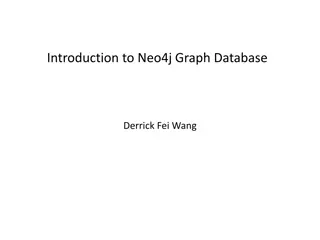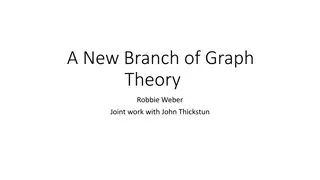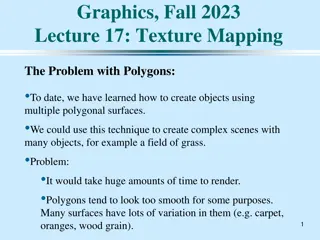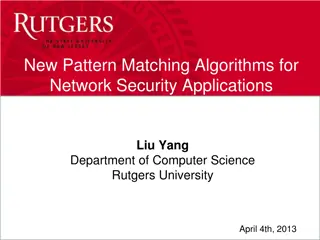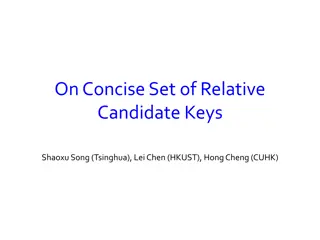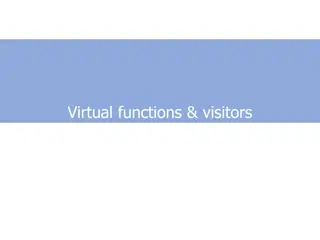Virtual Network Mapping: A Graph Pattern Matching Approach
Virtual Network Mapping (VNM) involves deploying virtual network requests in data center networks in response to real-time demands. It facilitates the deployment of virtual networks on physical machines by mapping virtual nodes and links onto substrate nodes and paths, ensuring constraints are met. Existing models like Virtual Machine Placement (VMP) and Single/Multi-path VN Embedding provide frameworks for VNM, but they may not cover all practical scenarios. Examples include mapping with latency constraints (VNML) for latency-sensitive applications and priority mapping (VNMP) for allocating bandwidth based on different priorities.
Download Presentation

Please find below an Image/Link to download the presentation.
The content on the website is provided AS IS for your information and personal use only. It may not be sold, licensed, or shared on other websites without obtaining consent from the author.If you encounter any issues during the download, it is possible that the publisher has removed the file from their server.
You are allowed to download the files provided on this website for personal or commercial use, subject to the condition that they are used lawfully. All files are the property of their respective owners.
The content on the website is provided AS IS for your information and personal use only. It may not be sold, licensed, or shared on other websites without obtaining consent from the author.
E N D
Presentation Transcript
Virtual Network Mapping: A Graph Pattern Matching Approach Yang Cao1,2, Wenfei Fan1,2, Shuai Ma2 1University of Edinburgh 2Beihang University 1
Virtual Network Mapping (VNM) Input: A substrate network (SN): a network of physical machines Substract nodes with CPU or storage capacities Physical edges with bandwidth or latency A virtual network (VN) Virtual nodes (VMs, machines or routers) with requirements on CPU or storage Virtual links (i.e., edges) with requirements on bandwidth or latency Output: Virtual network mapping: a deployment of VN in the SN Hosting on substrate nodes on virtual nodes Instantiating virtual links on physical paths Constraints on the virtual nodes and links are satisfied VNM helps to deploy virtual network requests in a data center network (Amazon EC2 & distributed DBs) in response to real-time requests! f: v VN v SN g: link (u, v) VN path (f(u), f(v)) SN 2
Existing Models on VNM in Different Settings Virtual machine placement (VMP) node mapping g: v VN v SN the capacity of v is no greater than that of v Single-path VN embedding (VNESP) node mapping g: v VN v SN edging mapping h: link (u, v) VN path (g(u), g(v)) SN constraints on nodes and edges are satisfied Multi-path VN embedding (VNEMP) g: v VN v SN h: link (u,v) a set of paths from g(u) to g(v) constraints on nodes and edges are satisfied However, many VN requests commonly found in practice could NOT be expressed in any of theses models! only nodes are considered nodes and links are both considered one virtual link can be mapped to multiple paths 3
Example 1: Mapping with Latency Constraints (VNML) Requirements on CPUs and latencies latency sensitive applications: multimedia transmitting networks g: v VN v SN satisfying constraints on CPU h: link (u, v) VN path (g(u), g(v)) SN the sum of the latencies of edges on the path (g(u), g(v)) does not exceed the latency specified by (u, v) 4
Example 2: Priority Mapping (VNMP) Requirements on CPUs and bandwidths g: v VN v SN satisfying constraints on CPU h: link (u, v) VN path (g(u), g(v)) SN the minimum bandwidth of all edges on the path (g(u), g(v)) is no less than the bandwidth specified for (u,v) we want to give different priorities at run time to virtual links that share some physical links, and require the mapping only to provide bandwidth guarantee for the connection with the highest priority 5
Example 3: Mapping with Node Sharing (VNMSP(NS)) Requirements on CPUs, bandwidths and node sharing An extension of the single-path VN embedding (VNMSP) g: v VN v SN h: link (u, v) VN path (g(u), g(v)) SN constraints on nodes and edges are satisfied from the practical need from X-Bone allowing mapping multiple virtual nodes to the same substrate nodes, i.e., node sharing VNM varies from practical requirements (latency, high-priority connections, node sharing) Existing models are not capable of expressing such requirements (e.g., VNML, VNMP, VNESP(NS)) It would be an overkill to develop a model for each case and study it individually A unified model is needed to express and analyze VNMs in various practical settings! 6
Outline A unified model to characterize VNMs in terms of graph pattern matching Complexity and approximation bounds for VNMs Conclusion and Future work 7
Graph Pattern Matching Model for VNM Virtual network matching (VNM) A node mapping (g, rV) from GP to GS Function g: VP VS, g(v)=v Function rV: VP VS N rV(v,v ): the amount of resource of the v that is allocated to v An edge mapping (h, rE) from Gp to Gs Function h: EP 2Es , h((u,v)) is a subset of paths from g(u) to g(v) Function rE: (EP, 2Es) N, rE(e,p) is the amount of resource of the physical path p allocated to the virtual link e Virtual network (VN) Weighted directed graphs GP= (VP, EP, fVp, fEp) Vs: set of vitual nodes Es: set of vitual links fVs: resource requirements on nodes fEs: resource requirements on links Substrate network (SN) Weighted directed graphs GS= (VS, ES, fVs, fEs) Vs: set of substrate nodes Es: set of physical edges fVs: resource capacities on nodes fEs: resource capacities on edges 8
Graph Pattern Matching Model for VNM (cont.) A VN request to an SN GS: (GP, C ) GP: VN C : a set of of global constraints on VNM Each constraint in C is one of the following Node constraints when a virtual node v is hosted by v , then v must provide adequate resource: fVp(v) r(v,v ) when a subtracted node v host (possibly multiple) virtual nodes, v must have sufficient capacity to accommodate all those virtual nodes: fVp(v ) sum{Rv(v, v )| v g(v)} Edge constraints when a virutal link e is mapped to a set of paths, those physical paths together satisfy the requirements of e: fEp(e) op agg{Re(e, p)| p h(e)}, op { , }, agg {min,max,sum} Each physical link has sufficient bandwidth to host all virtual links that are mapped to some physical path containing e the bandwidth of each path p allocated to a virtual link e can not exceed the minimum bandwidth of the physical links on p. All VN requests mentioned before can be formally expressed with the model Find more formal discussions in the paper 9
Graph Pattern Matching Model for VNM (cont.) A VN request (GP, C) can be mapped to an SN GSif there exists node mapping (g, rV) and edge mapping (h, rE) all the constraints of C are satisfied The VNM problem Input: an VN request (GP, C), an SN GS Question: whether (GP, C) can be mapped to GS? 10
The Computational Complexity of VNM upper bound The VNM problem is in NP regardless of what constraints are present in PTIME when only node constraints are present, without node sharing virtual machine placement (VMP) all mapping extended with node sharing it becomes NP-complete when node sharing is requested it is NP-complete in the presence of edge constraints All the results hold even when both VNs and SNs are DAGs Priority mapping (VNMP) mapping with latency constraints (VNML) single-path VN embedding (VNESP) multi-path VN embedding (VNEMP) 11
The Optimization Problem of VNM Find a VNM mapping with the lowest cost each node and edge in SN is associated with a price of the resources the cost of a VNM mapping ((g, rV), (h, rE)) from (GP, C) to GS informally, the sum of all prices of nodes and edges involved in the mapping the more CPU (bandwidth) resource is allocated, the higher the cost it incurs when latency is considered, the cost of the edge mapping is determined only by edge mapping h, whereas the resource allocation function is irrelevant. the cost function is motivated by economic models of network virtualization 12
The Optimization Problem of VNM The minimum cost mapping problem Input: an VN request (GP, C), an SN GS , a cost function c Output: a mapping ((g, rV), (h, rE)) from (GP, C) to GS with minimum cost The VNM problem is in PTIME for VMP without node sharing; however, when node sharing is quested, it becomes APX-hard NPO-complete for VNM for VNMP, VNESP, VNEMP, VNML, VNMP(NS), VNESP(NS), VNML(NS) APX-hard when there is a unique node mapping in the presence of edge constraints. In particular, VNMPdoes not admit ln(|VP|)-approximation, unless P=NP The NPO-hardness results remain intact even when both VNs and SNs are DAGs 13
Conclusion and Future Work Summary A uniform model for VNM based on graph pattern matching Richer graph pattern matching semantics can be found in areas other than pure DB DB ideas can help other areas to develop deeper understanding (and design algorithms) Complexity and approximability analysis Show why there are limited related works on efficient algorithms for VMP Future work Algorithms for new VN requests under the model Partly done Find more interesting semantics for graph pattern matching 15






